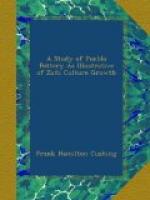[Illustration: FIG. 518.—Cooking-pot
of corrugated ware, showing
conical
projections near rim.
Pueblo coiled pottery developed from basketry.—Seizing the suggestion afforded by the rude tray-molded parching-bowls, particularly after it was discovered that if well burned they resisted the effects of water as well as of heat, the ancient potter would naturally attempt in time to reproduce the boiling-basket in clay. She would find that to accomplish this she could not use as a mold the inside of the boiling-basket, as she had the inside of the tray, because its neck was smaller than its body. Nor could she form the vase by plastering the clay outside of the vessel, not only for the same reason, but also because the clay in drying would contract so much that it would crack or scale off. Naturally, then, she pursued the process she was accustomed to in the manufacture of the basket-bottle. That is, she formed a thin rope of soft clay, which, like the wisp of the basket, she coiled around and around a center to form the bottom, then spirally upon itself, now widening the diameter of each coil more and more, then contracting as she progressed upward until the desired height and form were attained. As the clay was adhesive, each coil was attached to the one already formed by pinching or pressing together the connecting edges at short intervals as the winding went on. This produced corrugations or indentations marvelously resembling the stitches of basket-work. Hence accidentally the vessel thus built up appeared so similar to the basket which had served as its model that evidently it did not seem complete until this feature had been heightened by art. At any rate, the majority of specimens belonging to this type of pottery—especially those of the older periods during which it was predominant—are distinguished by an indented or incised decoration exactly reproducing the zigzags, serrations, chevrons, terraces, and other characteristic devices of water-tight basketry. (Compare Figs. 516, 517 with Figs. 507, 508.) Evidently with a like intention two little cone-like projections were attached to the neck near the rim of the vessel (see Fig. 518) which may hence be regarded as survivals of the loops whereby it has been seen the ends of the strap-handle were attached to the boiling-basket. (See again Fig. 503, a.) Although varied in later times to form scrolls, rosettes, and other ornate figures (see Fig. 519), they continued ever after quite faithful features of the spiral type of pot, and may even sometimes be seen on the cooking-vessels of modern Zuni. To add yet another link to this chain of connection between the coiled boiling-basket and the spirally-built cooking-pot, the names of the two kinds of vessels may be given. The boiling-basket was known as wo li a k’ia ni tu li a tom me, the corrugated cooking pot as wo li a k’ia te’ ni tu li a ton ne, the former signifying “coiled cooking-basket,” the latter “coiled earthenware cooking-basket.”




